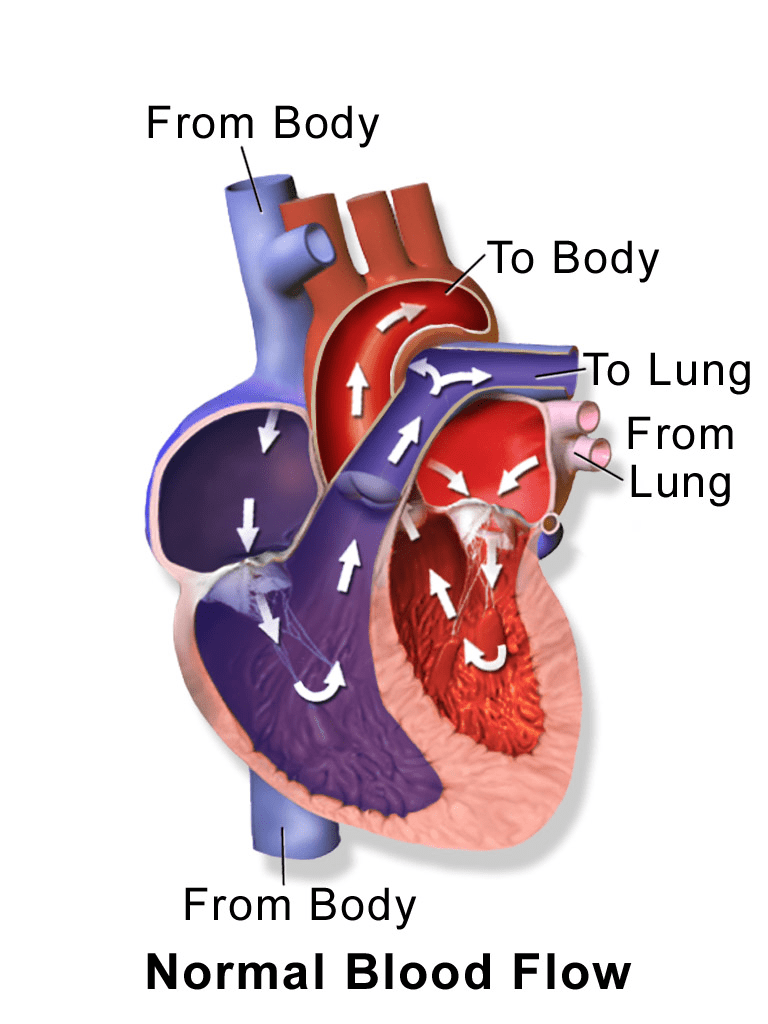

Well-trained athletes can have much larger hearts due to the effects of exercise on the heart muscle, similar to the response of skeletal muscle. The heart is often described as the size of a fist: 12 cm (5 in) in length, 8 cm (3.5 in) wide, and 6 cm (2.5 in) in thickness, although this description is disputed, as the heart is likely to be slightly larger. An adult heart has a mass of 250–350 grams (9–12 oz). The heart is cone-shaped, with its base positioned upwards and tapering down to the apex. Because the heart is between the lungs, the left lung is smaller than the right lung and has a cardiac notch in its border to accommodate the heart. The largest part of the heart is usually slightly offset to the left side of the chest (though occasionally it may be offset to the right) and is felt to be on the left because the left heart is stronger and larger, since it pumps to all body parts. The lower tip of the heart, the apex, lies to the left of the sternum (8 to 9 cm from the midsternal line) between the junction of the fourth and fifth ribs near their articulation with the costal cartilages. The upper part of the heart is located at the level of the third costal cartilage. The upper part of the heart is the attachment point for several large blood vessels-the venae cavae, aorta and pulmonary trunk. The back surface of the heart lies near the vertebral column, and the front surface sits behind the sternum and rib cartilages. A double-membraned sac called the pericardium surrounds the heart and attaches to the mediastinum. The human heart is situated in the mediastinum, at the level of thoracic vertebrae T5- T8. The human heart is in the middle of the thorax, with its apex pointing to the left. Specialists who focus on diseases of the heart are called cardiologists, although many specialties of medicine may be involved in treatment. Diagnosis of heart disease is often done by the taking of a medical history, listening to the heart-sounds with a stethoscope, ECG, echocardiogram, and ultrasound. Cardiovascular diseases frequently do not have symptoms or may cause chest pain or shortness of breath. Risk factors include: smoking, being overweight, little exercise, high cholesterol, high blood pressure, and poorly controlled diabetes, among others. Of these more than three-quarters are a result of coronary artery disease and stroke. Ĭardiovascular diseases (CVD) are the most common cause of death globally as of 2008, accounting for 30% of deaths. Exercise temporarily increases the rate, but lowers resting heart rate in the long term, and is good for heart health. The heart beats at a resting rate close to 72 beats per minute. Oxygenated blood then returns to the left atrium, passes through the left ventricle and is pumped out through the aorta into systemic circulation, traveling through arteries, arterioles, and capillaries-where nutrients and other substances are exchanged between blood vessels and cells, losing oxygen and gaining carbon dioxide-before being returned to the heart through venules and veins. From here it is pumped into pulmonary circulation to the lungs, where it receives oxygen and gives off carbon dioxide. In humans, deoxygenated blood enters the heart through the right atrium from the superior and inferior venae cavae and passes it to the right ventricle. These generate a current that causes the heart to contract, traveling through the atrioventricular node and along the conduction system of the heart. The heart pumps blood with a rhythm determined by a group of pacemaker cells in the sinoatrial node. The wall of the heart is made up of three layers: epicardium, myocardium, and endocardium. The heart is enclosed in a protective sac, the pericardium, which also contains a small amount of fluid.

In a healthy heart blood flows one way through the heart due to heart valves, which prevent backflow. Fish, in contrast, have two chambers, an atrium and a ventricle, while reptiles have three chambers. Commonly the right atrium and ventricle are referred together as the right heart and their left counterparts as the left heart. In humans, other mammals, and birds, the heart is divided into four chambers: upper left and right atria and lower left and right ventricles. In humans, the heart is approximately the size of a closed fist and is located between the lungs, in the middle compartment of the chest. The pumped blood carries oxygen and nutrients to the body, while carrying metabolic waste such as carbon dioxide to the lungs. The heart is a muscular organ in most animals that pumps blood through the blood vessels of the circulatory system.


 0 kommentar(er)
0 kommentar(er)
